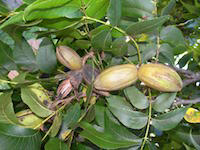 November 21, 2023 - In Texas, it seems like everyone has a soft spot for pecans. It should be a law. After all, it's our state tree. Don't ask me why it's named after Illinois – I've often wondered that myself. It would have made more sense to name it after Texas, Louisiana, or Mississippi, where these delectable nuts are most common in the wild and flourish in rich river bottom soils. Texas typically takes the lead in native pecan production, and cooks and candy makers will attest that the small, oil-rich native pecans offer the finest flavor.
November 21, 2023 - In Texas, it seems like everyone has a soft spot for pecans. It should be a law. After all, it's our state tree. Don't ask me why it's named after Illinois – I've often wondered that myself. It would have made more sense to name it after Texas, Louisiana, or Mississippi, where these delectable nuts are most common in the wild and flourish in rich river bottom soils. Texas typically takes the lead in native pecan production, and cooks and candy makers will attest that the small, oil-rich native pecans offer the finest flavor.
Pecan trees are generally planted in the fall or winter, and you can find them in both bare-root and containerized forms. When planting bare-root pecans, it's crucial to do so while they are in their dormant state during the winter. Containerized plants, on the other hand, can be planted year-round, provided there's sufficient moisture. Fall is the optimal time, followed by winter, spring, and lastly, summer (not ideal). It's recommended to space pecans about 50 feet apart.
To bear nuts, pecan trees require cross-pollination with another cultivar or seedling. Pecan cultivars fall into two categories: some produce male flowers (pollen) first, while others produce female flowers (future pecans) first. Each type naturally pollinates the other. It's essential to plant at least one cultivar from each category or have native pecans nearby. Pecans are pollinated by the wind and can cross-pollinate up to a quarter of a mile away.
Pecan trees thrive when they receive at least eight hours of direct sunlight, preferably more. While they can grow in various soil types, they produce the best results in deep, fertile, well-drained soils. Generally, they need irrigation during the summer to yield a good crop of nuts.
When planting, dig a hole twice as wide as the tree's root ball and as deep as the roots or pot it came in. Water the root ball in the hole, then backfill with the native soil. Be sure not to plant the tree too deep, as it can be fatal. Create a circular berm around the tree to collect water, and water the tree once a week until it's established. Maintain a 4-inch deep and 4-foot-wide ring of mulch (compost, bark, pine straw, etc.) around the tree's base until it exceeds 6 inches in diameter. This mulch helps conserve moisture and keeps the soil at a suitable temperature throughout the seasons, while also preventing weeds and grass from interfering with the tree's growth. It's worth noting that both tree and grass roots compete for the same oxygen-rich soil area. Additionally, the mulch ring shields the tree's delicate bark from harm by lawn mowers and string trimmers.
Pecans can face a range of potential insect and disease issues, including aphids, phylloxera gall, pecan nut casebearer, scab, and fall webworms. You can find prevention and control methods on the Aggie Horticulture website under "Fruit and Nut Resources."
Pecans mature in the fall and will fall to the ground when they're ready. Leave them to dry for a few more weeks in a well-ventilated area, and then store them in the refrigerator or freezer.
Remember, pecans aren't self-fertile, so you'll need two compatible cultivars for cross-pollination. Check out the Aggie Horticulture website for a list of suitable cultivars. In East Texas, recommended pecan cultivars include Apalachee, Caddo, Desirable, Elliott, Forkert, Kanza, Lakota, Lipan, Mandan, Oconee, Pawnee, and Prilop. Avoid western cultivars prone to scab disease in this region.








